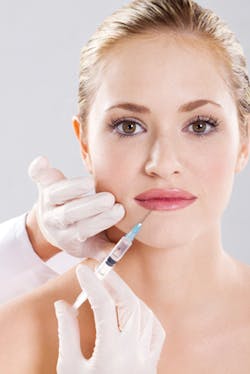Administering dermal fillers: Freaky or fabulous? Nevada's surprise decision led to Facebook debate
By Heidi Emmerling Muñoz, PhD
"Finally!" "Way to go, Nevada!" "It's about time!" "Horrors!" "Seriously?!"
These are some of the mixed reactions posted within the comments of a December 21, 2015 RDH Facebook post about a DentistryIQ article announcing Nevada as the first state to allow dental hygienists to administer botulinum toxin (Botox/Xeomin) and dermal fillers.1 How did this come about, and what are the implications for dental hygienists?
According to Caryn Solie, RDH, who is the past president of the American Dental Hygienists' Association (ADHA), and one of the dental hygienists on the Nevada State Board of Dental Examiners at the time: "It all came about unexpectedly at [the dental board] meeting. No planning by either association. The education requirements are now being considered by the state dental board."
Indeed, this was sudden. When I asked several Nevada-licensed dental hygienists for their reactions, most were not aware of the board's decision to allow dental hygienists to administer dermal fillers.
Discussion at board meeting
The minutes of the November 20, 2015 meeting reflect that Nicole Mackie, DDS, a prosthodontist, requested an advisory opinion about whether a person who has a specialty license in the area of prosthodontics is able to administer Botox, dermal fillers, or other injectables.2 Next, Stephen Sill, DMD, PC, a general dentist, speaking on behalf of Jonathan White, DDS, stated that general dentists can be trained at the same level as other providers and suggested that if dentists possessed "the adequate skill, training, and [ability to] safely administer these agents to patients," then they should be allowed to do so.2
Following a motion by Byron Blasco, DMD, Solie "inquired as to whether a dental hygienist who receives adequate training and possesses the skills necessary to safely administer Botox and dermal fillers [should] be allowed [to do so] under the supervision of a dentist."2
READ |
Dr. Blasco amended his motion to include hygienists, the motion was passed, and the board issued the opinion that: "a person who holds a valid dental license and who possesses the skills and training to safely administer injectables (Botox and dermal fillers) be allowed and that a licensed dental hygienist who possesses adequate skills and training to safely administer injectables (Botox and dermal fillers), but that a dental hygienist may only administer to a patient under the direct supervision of a Nevada-licensed dentist who has the same adequate training and skills to safely administer the injectables (Botox and dermal fillers)."2
There is, of course, debate over who is genuinely qualified to administer Botox. Some believe that only dermatologists are qualified. Others broaden it to any trained physician, while others believe registered nurses (RNs) are fully qualified. New York, Florida, Texas, California, and Oklahoma are among the states allowing nurses to administer dermal fillers.3 While most states already allow dentists to administer dermal fillers, Nevada is the first state to permit dental hygienists to do so.
Training for dermal fillers
In a comment to the Facebook post, Louis Malcmacher, DDS, MAGD, the president of the American Academy of Facial Esthetics (AAFE), wrote, "This is all about oral health! The AAFE and I have been training dental professionals since 2008, and it is just a matter of education so you understand how Botox and fillers are used in dentistry and for oral health. [. . .] We went through this same discussion when Botox and fillers hit dentistry in 2008 when they became more popular. Now, the AAFE gives its training course at the ADA annual session, so we are talking about oral health!"
The course Dr. Malcmacher references covers many topics, including:
- Indications and contraindications for these pharmaceutical agents4
- In-depth instruction in the anatomy, neurophysiology, musculature, and circulatory system of the oral and maxillofacial areas4
- Patient evaluation for the best dental and facial esthetic and therapeutic outcomes4
- Review of sterile technique as it relates to the use of injectable pharmacologic agents4
- Safety and risk issues for botulinum-toxin and dermal-fillers injectable therapy4
- The physiology and pharmacology of oral and maxillofacial injectable treatment4
- Integrating botulinum-neurotoxin and dermal-filler therapy into therapeutic and esthetic treatment plans4
- Volumizing nasolabial folds, marionette lines, and lifting up the corners of the mouth using anatomical landmarks4
- Beautiful and subtle lip enhancements by adding volume to establish proper lip and smile lines4
- Smoothing lip lines and eliminating vertical "smokers" lines4
- Treatment techniques, including anatomical muscle sites, muscle depths, proper preparation, and dilution for the best oral and maxillofacial therapeutic and esthetic outcomes4
- Botulinum-toxin therapeutic treatment for bruxism to relieve temporomandibular joint disorders (TMJ/TMD)4
- How to avoid, manage, and treat possible adverse reactions and complications4
Despite the fact that courses are in place for dental professionals, the board is still working on approving the requirements, according to Solie. Not everyone is thrilled with this new development. Comments on the aforementioned Facebook post indicate that some believe that administering Botox detracts from the focus on oral health and that some consider the administration of dermal fillers by hygienists to be a lawsuit waiting to happen.
Facebook Discussion
In the comments of the December 21 RDH Facebook post, Andrea Waters-Grammatica wrote, "This is not an appropriate direction for oral-health preventive practitioners to go! I am sadly disappointed and really concerned for the well-being of patients. Take a weekend course and start injecting Botox and fillers?! OMG. We have enough responsibility with oral cancer, prevention of periodontal disease, and [oral hygiene instructions]!"
Karen Clark Panagotopulos asked, "How would hygienists be compensated for this extra training and revenue brought into the dental office? Where I am, being licensed to give local anesthesia has not proven to raise a salary significantly. I fear this would be the same. We have to learn more, know more, be responsible for more . . . and not get compensated for it."
Tanara Block asked, "Who goes to the dentist looking for Botox anyway? This is absurd. We are here to promote oral health. What on earth does Botox have to do with that? Absolutely nothing, that's what."
Although there is some concern about dental hygienists administering Botox and other dermal fillers, 1,000 "likes" on the Facebook post suggest that many are on board, including the following:
- "If there wasn't a need for change, we'd still be just polishing teeth! Why wouldn't you want to expand your duties? [. . .] I think it [would be] awesome if we could add more to our list of duties. [It] would take us away from the monotony of doing prophies and perio [maintenance], and [it] could give us a chance to work in a different setting. Why not embrace this?"
- "Why wouldn't you want your dentist to administer Botox or fillers? Who else would you want to fix your gummy smile or the black triangles in your smile line? [. . .] My dentist administers Botox and fillers, and I approve of this 100%!"
- "Registered nurses can do it, but dental hygienists who have much more head-and-neck training are not allowed to. [I have always been incredulous] that RNs are allowed to do this."
- "It's about time. Oral surgeons have been doing chin/cheek implants for decades. Orthodontists offer teeth realignment for cosmetic-only reasons. General dentists do bondings, veneers, bleaching, gingival grafting/reduction, even crowns for cosmetic reasons, and they alter tooth structure irreversibly. Botox and dermal fillers are temporary and 'skin deep.' All are done with no other reason than patients wanting to feel good about their appearances (which has a positive effect [on] mental health, social approval, even earnings). Like any other elective procedure, if patients are aware of risks involved [and] probable outcomes, and [if] they have the financial means, it should be their option. And who better [to provide it] than trained, licensed professionals in an aseptic health-care setting?"
Others reminded Facebook visitors that dermal fillers are not strictly cosmetic:
- "To administer in a dental office, it has to be for a dental reason, not just to get rid of fine lines and wrinkles. Think Bell's palsy. Think TMD. None of the injections are for plumping your lips for New Year's Eve parties."
- "This is awesome! There are many benefits for facial pain and headaches [and for] TMJ pain. It is much less involved than giving anesthetic, and it is not permanent."
Because this development is so new, and perhaps because (at the time of this writing) the Nevada Dental Hygienists' Association has yet to release the news and comment, many Nevada hygienists are unaware and have not thought about how they feel about it. According to Lancette VanGuilder, RDH, a Nevada hygienist and ADHA District XII Trustee, social media published the board's new development before the Nevada Dental Hygienists' Association prepared an official public comment. "Social media kind of ruined that . . . [the] NVDHA will most likely not respond to the information until those meeting minutes have been approved," said VanGuilder. Approval can take up to 12 months.
While the rest of the country awaits the NVDHA's celebratory announcement, the dental hygiene community will continue to ponder: the implications of hygienists administering dermal fillers, the arguments for and against hygienists administering dermal fillers, and how the arguments regarding fillers parallel those regarding local anesthesia. When hygienists were granted the duty of administering local anesthesia, people were fearful that there would be an avalanche of botched injections, medical emergencies, and lawsuits. This has yet to happen. People were fearful that hygienists would become injection machines for dentists in assembly-line practices instead of focusing on periodontal health. This, too, has yet to happen.
These same types of fears are echoed in the some of the comments cited above. Are they unfounded? Katie Marie Tillman sums it up well: "If you're against it, don't get the training or certification to do it! [. . .] There are many benefits for Botox [aside from] cosmetics, but I think it's great that we can do the cosmetic side of it, as well. [. . .] The more we expand our abilities in this profession, the more autonomy and respect we get." RDH
Heidi Emmerling Muñoz, PhD, is a professor of English at Cosumnes River College in Sacramento, where she teaches all levels of writing. Dr. Muñoz is also a delegate to the American Federation of Teachers (AFT) union. Prior to her current position, Dr. Muñoz was a CODA site consultant with the ADA, interim director, professor of dental hygiene at Sacramento City College, past NVDHA president, and a Nevada-based private-practice clinical hygienist for more than 20 years. She has written numerous articles and columns and is a frequent contributor to RDH magazine. Dr. Muñoz can be reached at [email protected]
References
1. "AAFE prepares courses for hygienists allowed to treat with dermal fillers in Nevada." DentistryIQ. http://www.dentistryiq.com/articles/2015/12/nevada-allows-dental-hygienists-to-treat-with-facial-injectables.html. Published December 16, 2015.
2. "AO-15-1120." Meeting minutes from: Nevada State Board of Dental Examiners meeting; November 20, 2015; Las Vegas, NV. http://dental.nv.gov/uploadedFiles/dentalnvgov/content/Licensure/Resources/AO-15-1120%20Botox_Dermal%20Fillers_Injectables%20administered%20by%20Prosthodontists%20and%20General%20Dentists.pdf.
3. Walden J. "How to choose who will administer your Botox." Shape magazine website. http://www.shape.com/latest-news-trends/how-choose-who-will-administer-your-Botox.
4. "Botox & Dermal Filler Course Outline." American Academy of Facial Esthetics website. https://www.facialesthetics.org/events/las-vegas-nevada-january-28-29-frontline-tmj-orofacial-pain-Botox-dermal-fillers.







